NIOS Class 12 Biology Chapter 4 Cell – Structure and Function Solutions to each chapter is provided in the list so that you can easily browse throughout different chapters NIOS Class 12 Biology Chapter 4 Cell – Structure and Function Notes and select need one. NIOS Class 12 Biology Chapter 4 Cell – Structure and Function Question Answers Download PDF. NIOS Study Material of Class 12 Biology Notes Paper 314.
NIOS Class 12 Biology Chapter 4 Cell – Structure and Function
Also, you can read the NIOS book online in these sections Solutions by Expert Teachers as per National Institute of Open Schooling (NIOS) Book guidelines. These solutions are part of NIOS All Subject Solutions. Here we have given NIOS Class 12 Biology Chapter 4 Cell – Structure and Function Solutions, NIOS Senior Secondary Course Biology Solutions for All Chapter, You can practice these here.
Cell – Structure and Function
Chapter: 4
MODULE – I: DIVERSITY AND EVOLUTION OF LIFE
NIOS TEXTBOOK QUESTIONS ANSWERS
INTEXT QUESTIONS 4.1
1. From where do new cells arise?
Ans. Pre-existing cells.
2. Name the scientists who proposed the cell theory.
Ans. Schleiden and Schwann.
3. Name an organelle which a plant cell has but an animal cell does not.
Ans. Plastids.
4. Give two points of difference between a prokaryotic and eukaryotic cell.
Ans. (i) Prokaryotic Cell: In prokaryotic, there is naked nucleus. The cell organelles are absent except ribosomes.
(ii) Eukaryotic Cell: It has a distinct nucleus with a nuclear membrane. The cell organelles are present.
INTEXT QUESTIONS 4.2
1. Define diffusion and osmosis.
Ans. (i) Diffusion: It is defined as “the movement of molecules from region of their higher concentration to region of their lower concentration.”
(ii) Osmosis: It is defined as “the movement of water molecules across a membrane from region of their higher concentration to that of lower concentration”.
2. What does active transport mean?
Ans. Active transport means “the movement of molecules against concentration gradient that is region of lower to higher concentration by expending energy”.
3. Give one point of difference between phagocytosis and pinocytosis.
Ans. (i) Intake of solid particles is called phagocytosis.
(ii) Intake of fluid droplets is called the pinocytosis.
4. Match the following:
| (i) hydrophilic end | (a) cell wall |
| (ii) microfibrils | (b) inner ends of lipids |
| (iii) fluid-mosaic model | (c) fluid droplets |
| (iv) hydrophobic end | (d) outer ends of lipids |
| (v) pinocytosis | (e) Nicolson and Singer |
Ans.
| (i) hydrophilic end | (d) outer ends of lipids |
| (ii) microfibrils | (a) cell wall |
| (iii) fluid-mosaic model | (e) Nicolson and Singer |
| (iv) hydrophobic end | (b) inner ends of lipids |
| (v) pinocytosis | (c) fluid droplets |
5. Give two functions of the plant cell wall.
Ans. Two functions of plant cell-wall are:
(i) Protection of inner parts of cell.
(ii) Provides communication between cells through the plasmodesmata.
INTEXT QUESTIONS 4.3
1. What is a cell organelle?
Ans. Membrane bound bodies in the cytoplasm of a cell.
2. Name the chemical which provides energy trapped in its bonds to the cell.
Ans. ATP.
3. Which part of the chloroplasts is the site of light reaction?
Ans. Grana.
4. Name the sac like-structure which form the grana?
Ans. Thylakoids.
5. Why is mitochondria called the “power house” of the cell?
Ans. As energy (ATP) is generated and stored in the mitochondria.
6. Which organelle contains enzymes for cellular respiration?
Ans. Mitochondria.
7. State two similarities between mitochondria and chloroplast.
Ans. (i) Both are semiautonomous.
(ii) Both possess DNA.
(iii) Both have ribosomes. (Write any two).
8. Which plastids impart colour to flower petals?
Ans. Chromoplast.
9. Which plastid is green in colour?
Ans. Chloroplast is green in colour.
10. Why are mitochondria and chloroplast called semi-autonomous?
Ans. They both possess their own DNA for production of more of themselves but cannot lead independent life.
INTEXT QUESTIONS 4.4
1. Given below is a list of functions, relate them to their respective organelles:
(a) Synthesis of some enzymes __________.
Ans. Golgi body.
(b) Synthesis of steroids _________.
Ans. Endoplasmic reticulum.
(c) Storage of Carbohydrates __________.
Ans. Endoplasmic reticulum.
(d) Intracellular Transport __________.
Ans. Endoplasmic reticulum.
(e) Synthesis of proteins __________.
Ans. Ribosomes.
2. Name the equivalent structure of golgi body in plants. Mention two differences between their structures.
Ans. Dictyosomes: They are equivalent to the golgi body in plants.
Two differences between Golgi Body and Dictyosomes:
| Golgi Body | Dictyosomes |
| 1. They are found near the nucleus. | They lie scattered in the cytoplasm. |
| 2. Usually one in number. | Mostly there are more in number. |
3. Mention any two advantages of the extensive network of endoplasmic reticulum.
Ans. Two advantages of ER-Network:
(i) Transport of the substances.
(ii) ER makes the internal framework.
4. What are the three places where ribosomes occur in a cell?
Ans. The three places are:
(i) Cytoplasm.
(ii) ER. and
(iii) Nucleolus.
5. Name the system that connects the nuclear membrane with the cell membrane.
Ans. Endoplasmic Reticulum (ER).
INTEXT QUESTIONS 4.5
1. Why are lysosomes called suicidal bags?
Ans. Because enzymes found in them can digest cells own material if damaged or dead.
2. List the usefulness of intracellular digestion by lysosomes.
Ans. (i) Take part in intracellular digestion of food.
(ii) Clean up the cell by digesting useless matter.
3. What is the function of peroxisomes in plant cells?
Ans. Fat metabolism.
INTEXT QUESTIONS 4.6
1. Why cannot the cell survive without the nucleus?
Ans. Because the nucleus controls all the functions of the cell as it has the hereditary information.
2. Explain the following terms:
(a) Chromatin network.
Ans. Chromosomes are present as a network when not dividing at interphase stage.
(b) Chromosomes.
Ans. The chromosomes are the bearers of hereditary information as genes on them.
3. What is the function of the nucleolus in the cell?
Ans. Site of synthesis of RNA in the cell.
INTEXT QUESTIONS 4.7
1. What is the importance of water in a living cell?
Ans. Importance of water (H₂O) in a living cell:
(i) Water is a universal solvent. The most chemical reaction of the cell takes place in aqueous medium.
(ii) Water is a constituent of the protoplasm.
2. What is the basic molecule in starch?
Ans. Glucose (C6H₁₂O6).
3. What is a peptide bond and where do you find it?
Ans. -NHCO-, lies between amino acid in a polypeptide bond and occurred in proteins.
4. Which is the most energy con-taining biomolecule in living organisms?
Ans. ATP.
5. What are nucleotides?
Ans. They are building blocks of nucleic acids, each containing three units:
(i) a pentose sugar.
(ii) nitrogenous base. and
(iii) phosphate group.
INTEXT QUESTIONS 4.8
1. Explain in one sentence:
(i) Interphase _________.
Ans. Interphase (Inter = in between): It is resting phase between two cell divisions.
(ii) Synthetic Phase _________.
Ans. Synthetic phase: Replication of DNA occurs in this phase.
(iii) Dividing Phase __________.
Ans. Dividing phase: It includes mitosis cell division.
2. What is the full form of the following in the cell cycle?
(a) G1 _________.
Ans. G₁ = First Growth Phase.
(b) S _________.
Ans. S = Synthetic Phase.
(c) G2 _________.
Ans. G₂ = Second Growth Phase.
(d) M-Phase _________.
Ans. M-Phase = Mitosis Phase.
INTEXT QUESTIONS 4.9
1. Name the stage of cell cycle during which chromatin material is duplicated.
Ans. The interphase.
2. Is the number of chromosomes reduced in the daughter cells during mitosis? Yes/No?
Ans. No. The number of chromosomes is not reduced in the daughter cells during mitosis cell division.
3. Name the stage in nuclear division described by each of the following sentences:
(i) Disappearance of the nuclear membrane.
Ans. Stage – Prophase.
(ii) The nuclear membrane and nucleolus reappear.
Ans. Stage – Telophase.
(iii) The centromere divides and the chromatids move to opposite poles due to the shortening of spindle fibres.
Ans. Stage – Anaphase.
(iv) The chromosomes arrange themselves at the equatorial plane of the spindle with the spindle fibres attached to the centromeres.
Ans. Stage Metaphase.
INTEXT QUESTIONS 4.10
1. Name the sub-stage of meiosis-I in which the:
(i) Homologous chromosomes pair.
Ans. Substage – Zygotene (prophase I).
(ii) Tetrads are formed.
Ans. Substage – Pachytene.
(iii) Homologous chromosomes begin to move from each other.
Ans. Substage – Diakinesis.
2. Site of meiosis in flowering plants are.
Ans. (i) Microspore mother cells.
(ii) Megaspore mother cells.
3. Rearrange the following stages of meiosis I in their proper sequence:
zygotene, pachytene, leptotene, metaphase-I diakinesis, anaphase-I, telophase-I.
Ans. Leptotene, zygotene, pachytene, diplotene, diakinesis, metaphase-I, telophase-I.
4. Mention two major points in which meiosis I differs from meiosis II.
Ans. Two Major Points of Difference between Meiosis I and Meiosis II:
| S.No. | Meiosis I | Meiosis II |
| 1 | Number of chromosomes reduced to half. Crossing over takes place. | Number of chromosomes remains the same. No crossing over occurs in it. |
| 2 | Prophase I is of long duration. | Prophase II is of short duration. |
TERMINAL EXERCISES
1. Justify the statement that cell wall although a dead material, influences living processes inside the cell.
Ans. The cell wall influences living processes inside the cell which are given below:
(i) It reduces water loss by transpiration.
(ii) It helps in the transport of substances-water and chemicals.
(iii) Its enzyme activity is related to the metabolism.
(iv) By growth it provides existence of the cell.
(v) It retains turgidity of the cell.
(vi) Water and chemicals pass out of the cell and into the cell.
(vii) It binds the adjacent cells by middle lamella.
(viii) It gives mechanical supports.
2. Differentiate between cell wall and cell membrane.
Ans. Differences between Cell wall and cell membrane.
| Cell Wall | Cell Membrane |
| 1. Exclusively found in plant cells. | Found in animal and plant cells both. |
| 2. It consists of cellulose. | It consists of protein and lipids. |
| 3. It has thickenings of lignin, suberin etc. | No thickenings. |
3. Draw Singer and Nicholson’s model of cell membrane.
Ans. Fluid Mosaic Model of Singer and Nicholson (1972): Each phospholipid layer is biomolecular and the hydrophilic ends are pointed towards top and bottom respectively.
In this proteins are of two categories:
(i) Peripheral (extrinsic). and
(ii) integral (intrinsic).
The integral proteins are tightly held in place by strong hydrophilic or hydrophobic interactions or both and are difficult to remove from the membranes. To peripheral proteins are superficially arranged on either side and can be easily separated. These proteins have enzymatic properties and also makes membrane as selectively permeable. These proteins are referred to as permeases.
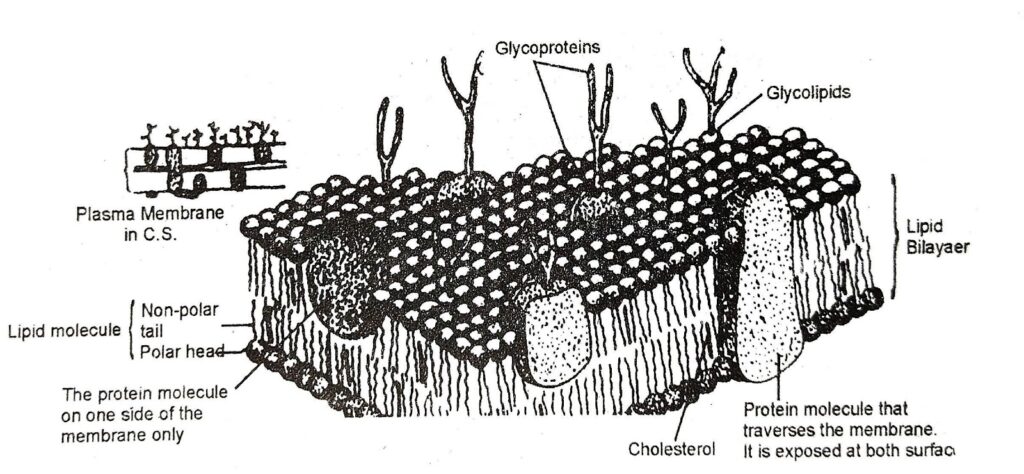
Fig. 4.37. Fluid mosaic model of all membranes as proposer by Singer and Nicholson.
This model has been widely accepted. The fluid mosaic model proposed by Singer and Nicholson explains that cell memberane is quasi fluid and is made of “Protein icebergs in sea of lipids”. It accounts for the dynamic nature of biomolecules. It provides growth, expansion and contraction of the membrane.
4. Why is cell membrane vital for the cell?
Ans. Cell membrane is vital for the cell. The reasons are given below:
(i) It has carrier molecules for active transport.
(ii) It forms boundary of the cell.
(iii) It protects the cell.
(iv) It always transports materials in and outside the cells.
(v) It is used during endocytosis and exocytosis.
5. Draw structure of mitochondria and chloroplast as seen by electron microscope.
Ans: See the figures:

Fig. 4.38. Structure of Mitochondrion as seen by E.M.
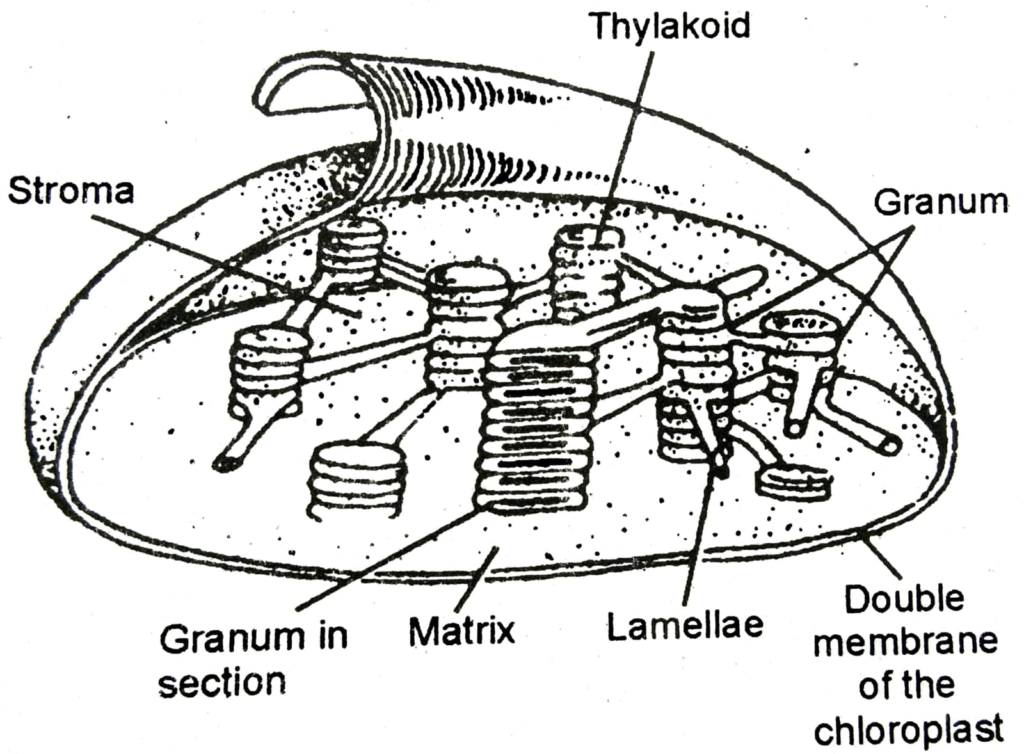
Fig. 4.39. Three-dimensional structure of the chloroplast as seen by E.M.
6. List functions of mitochondria and chloroplast.
Ans. (a) Functions of Mitochondria:
(i) Mitochondria oxidise pyruvic acid to release energy which is stored as ATP (cellular respiration).
(ii) They synthesise fatty acids as well as amino acids.
(b) Function of Chloroplast:
(i) They trap solar energy.
(ii) They carry out photosynthesis.
7. Name the self-duplicating cell organelles? Why are they called so?
Ans. Chloroplast and mitochondria are self-duplicating organelles. They possess DNA of their own. DNA is genetic material. They have RNA also. It is required for protein synthesis. So they can reproduce to make their own kind without involving the nucleus of the cell.
8. Differentiate between functions of ER, Ribosomes and Golgi bodies.
Ans. Differences between the functions of ER, Ribosomes and Golgi bodies.
| S.No. | ER | Ribosomes | Golgi bodies |
| 1 | Form the framework to cell. | Are sites of protein synthesis. | Secretion and synthesis of enzymes. |
| 2 | Rough Endoplasmic Reticulum (RER) is related to protein synthesis. | Free ribosomes help in synthesising enzyme proteins. | Synthesis of cell wall materials. |
| 3 | Smooth Endoplasmic Reticulum (SER) is related syn-thesis of glucogen and steroids. | Ribosomes attached to ER synthesise transport proteins. | They form acrosome of the sperm. |
9. Most organelles are membrane-bound. What is the advantage of such arrangement?
Ans. The membrane of the organelles allow the flow of materials and information between them. They maintain their identity. They maintain the internal environment also. They are specific in their function. They show retentivity also. So most cell organelles are membrane bound.
10. Differentiate between the structure and function of centriole and cilia/flagella.
Ans. Differences between Structure and Functions of Centrioles, Flagella and Ciliary:
| SL.No. | Centrioles | Cilia | Flagella |
| 1 | These are two in number. | They are many in number. | They are one or a few in number. |
| 2 | Take part in cell division. | Help in movement. | Help in movement. |
| 3 | Round in shape. | Elongated and short. | Elongated and large. |
| 4 | Has nine sets of peripheral tubules. | It has 9 sets of peripheral tubules and one set in centre. | Structure same like the cilia. |
11. Why are lysosomes known as “suicidal bags”?
Ans. Lysosomes are known are “suicidal bags” because they contain hydrolysing enzymes that “even may digest the cells own material when damaged or dead”.
12. What are the functions of nucleus?
Ans. Functions of the nucleus:
(i) Maintains working of the cell.
(ii) Contains genetic informations.
(iii) Passes hereditary material to next generation.
(iv) Essential for cell division.
(v) Takes part in genetic formation by meiosis cell division.
(vi) It coordinates the activities of cell organelles.
13. List the cell organelles. Write in one line each, about their functions and explain the division of labour.
Ans. Cell Organelles and Their Functions:
| Sl.No. | Cell organelles | Functions |
| 1 | Chloroplast | Seat of photosynthesis. |
| 2 | Mitochondria | Cellular respiration and ATP formation. |
| 3 | E.R. | Internal framework of the cell. |
| 4 | Golgi body | Secretion enzymes. |
| 5 | Ribosomes | Sites of protein synthesis. |
| 6 | Lysosomes | Contain hydrolysing en- zymes for digestion of food. |
| 7 | Peroxisomes | Fat metabolism in the cell. |
Division of Labour: It refers to “the allocation of different functions to different cell organelles.” Different cell organelles perform different functions.
14. Give the points of difference between:
(i) prokaryotic and eukaryotic cell.
Ans. Difference between Prokaryotic and Eukaryotic Cells:
| Prokaryotic Cell | Eukaryotic Cell |
| 1. Nucleoid present | Nucleus present. |
| 2. Hereditary material not enclosed by nuclear mem- brane. | Hereditary material en-closed by nuclear mem- brane. |
| 3. Ribosomes are of 70 S type. | Ribosomes are of 80 S type. |
| 4. Cell organelles absent. | Cell organelles present. |
| 5. No compartmentalization. | Compartmentalization is clear. |
| 6. It is a primitive type of cell. | It is an advanced cell. |

Fig. 4.40. A cell of E. coli-Prokaryotic cell.

Fig. 4.41. Eukaryotic cell.
(ii) plant and animal cell.
Ans. Differences between Animal Cell and Plant cell:
| S. No. | Animal Cell | Plant Cell |
| 1 | It is enclosed by an extremely thin mem-brane the plasma membrane. | Plasma membrane is covered over by a thick cell wall made of cellulose. |
| 2 | Chloroplasts are absent in animal cell. | Present in plant cell. |
| 3 | Vacuoles are either absent or of very small size. | Vacuoles present but large and prominent. |
| 4 | Centrosome present. | Centrosome absent. |
| 5 | Cell division takes place by the formation of a groove. | Cell division initia-tes by the formation of a cell plate. |
| 6 | Golgi complex or golgi body is present. | Golgi complex con- sisting of unconnec-ted units called the dictyosomes. |
| 7 | Crystals of calcium oxalate are always absent. | Crystals of calcium oxalate are always present in plant cells. |
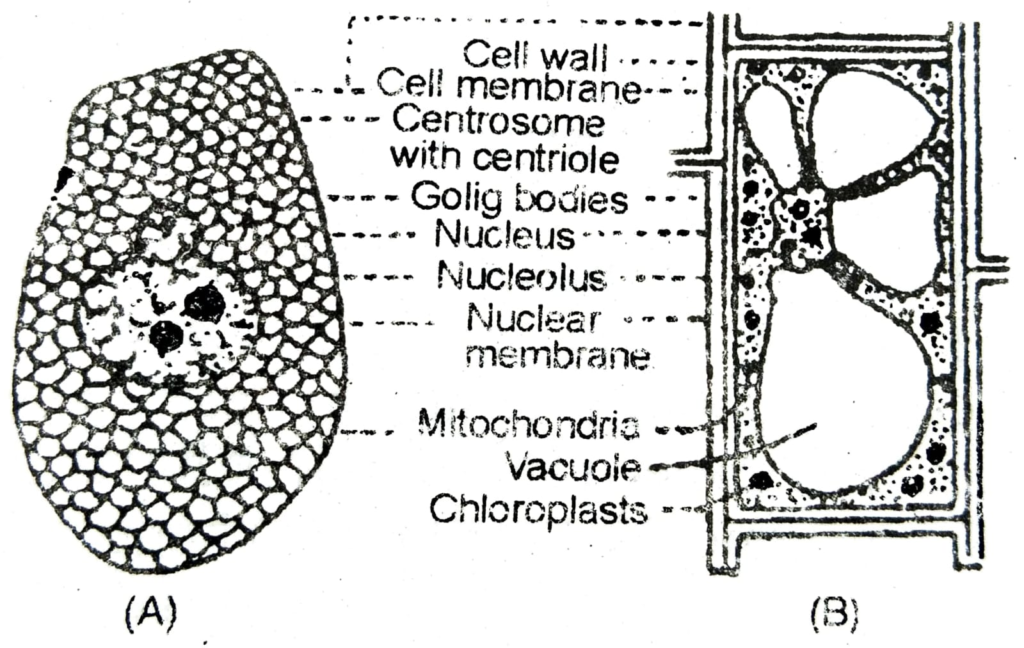
Fig. 4.42. (A) Animal cell, (B) Plant cell.
15. Why is cell termed the structural and functional unit of the organism?
Ans. As all living beings are made of cells; the cell is called structural and functional unit of life or organism. It performs all functions of body. Cell is the basic unit of body. Cell is the seat of all metabolic activities.
16. Name the following:
(i) The condition in which a cell has the normal paired chromosomes.
Ans. Diploid condition.
(ii) The condition in which a cell contains only one member of each pair of chromosomes.
Ans. Haploid condition.
(iii) The pairing of maternal and paternal chromosomes during meiosis.
Ans. It is called synapsis.
(iv) The exchange of parts in homologous (maternal and paternal) chromosomes during prophase-I of meiosis.
Ans. It is known as crossing over.
(v) The point by which a chromosome is attached to the spindle fibre.
Ans. It is called the centromere.
(vi) The type of cell division that results in growth.
Ans. The type of cell division is known as Mitosis.
17. What are the sites of meiosis in a flowering plant and in a sexually reproducing animal?
Ans. (i) Sites of Meiosis in a flowering plant: It occurs in the microspore mother cells of anthers and megaspore mother cells of the ovary in flowers.
(ii) Site of Meiosis in a sexually reproducing animal: It occurs in the testis of male and ovaries of the female animals.
18. List the sub-stages of prophase-I.
Ans. The substages of prophase-I are:
(i) Leptotene.
(ii) Zygotene.
(iii) Pachytene.
(iv) Diplotene. and
(v) the Diakinesis.
19. What is the significance of meiosis?
Ans. The Significance of Meiosis:
(i) It occurs in reproductive cells (germ cells) and results in the formation of gametes. The sex cells that are haploid.
(ii) The number of chromosomes is reduced to half in the daughter cells.
(iii) It leads to variations and genetic recombinations.
20. Draw a schematic diagram of various stages of the life-cycle of a cell.
Ans: See the figure:
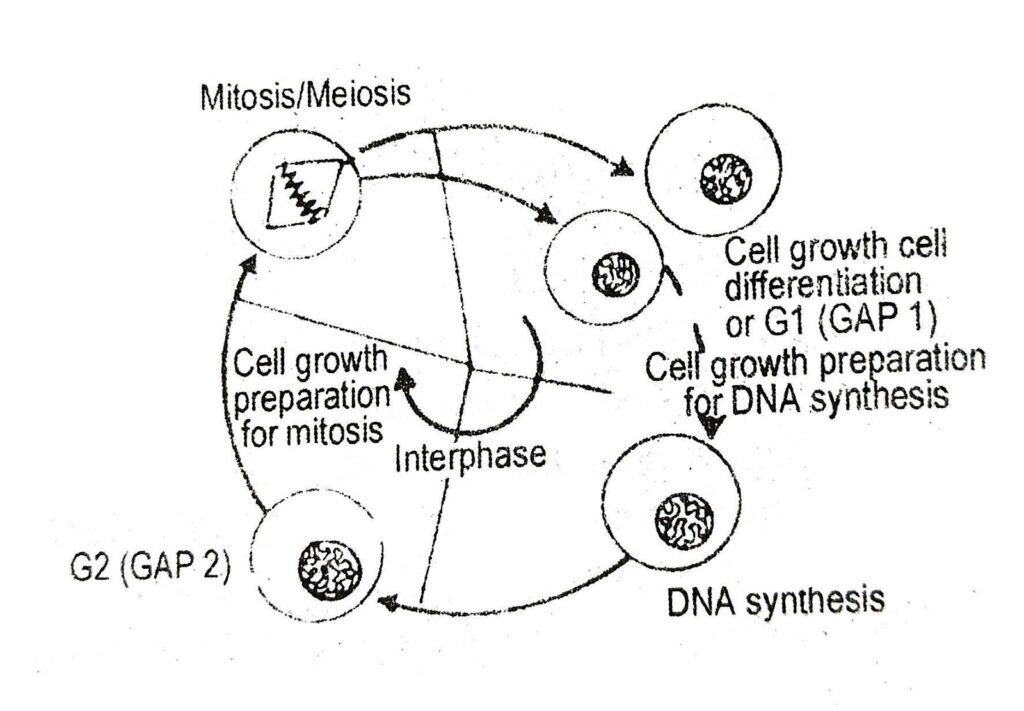
Fig. 4.43. Cell cycle.
21. Draw labelled diagrams of various stages of mitosis.
Ans. See the figure:
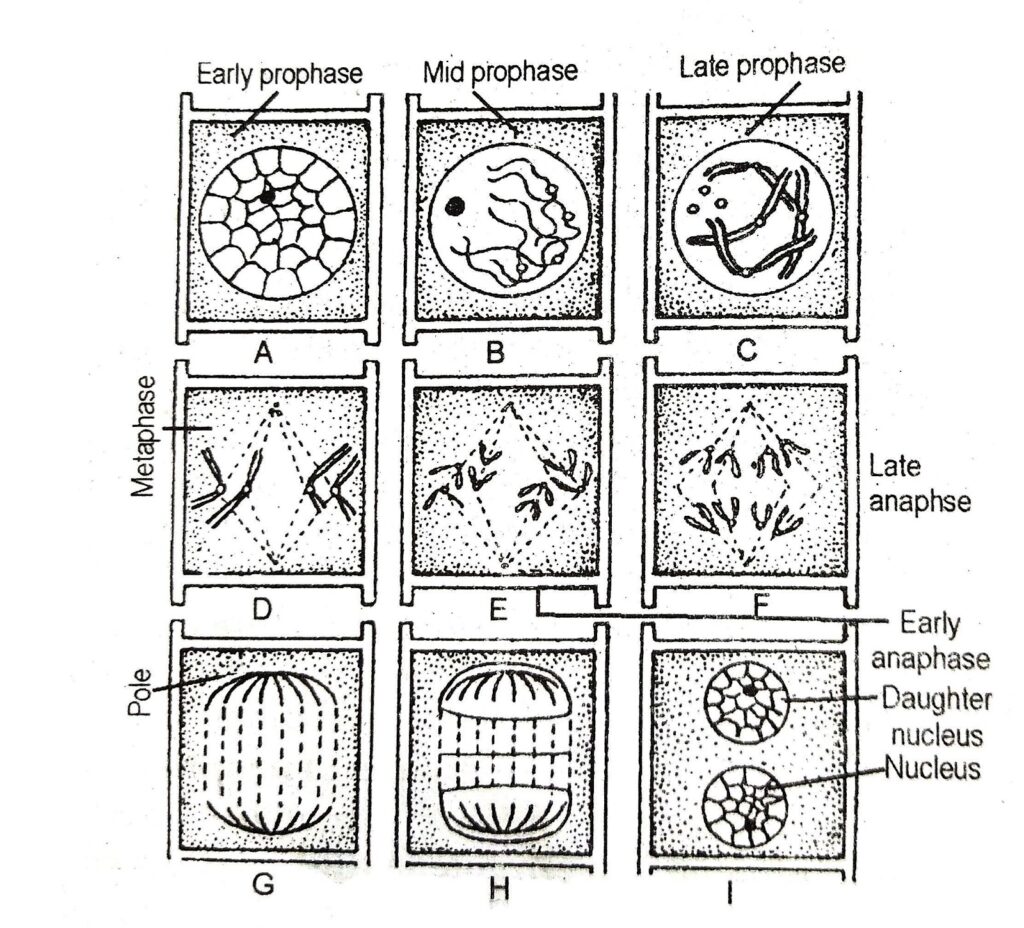
Fig. 4.44. Diagrams of various stages of mitosis in the plant cell.
22. Tabulate the main differences between mitosis and meiosis.
Ans. Main Difference between Mitosis and Meiosis:
| SL.No. | Mitosis | Meiosis |
| 1 | It occurs in the body cells. | It occurs in repro-ductive cells. |
| 2 | It occurs once. | It occurs as Meiosis I and then Meiosis II. |
| 3 | It is of short duration. | It is of long duration. |
| 4 | The prophase simple. | The prophase I is divided into 5 sub-stages-Leototene, Zygotene, Pachy-tene, Diplotene and the diakinesis. |
| 5 | Synapsis absent. | Synapsis occurs in Prophase-I. |
| 6 | No crossing over. | Crossing over occurs. |
| 7 | Duplication of chro-mosomes in the prophase. | Duplication of chromosomes in interphase I. |
| 8 | Growth and repair occur by mitosis. | Number of chromo-somes remains constant in the species for gene-rations. |
| 9 | Two daughter cells are formed. | Four daughter cells are formed. |
| 10 | Number of chromo-somes remains the same. | Chromosome number is reduced to half. |
23. Why is prophase of meiosis so prolonged and elaborate?
Ans. Prophase of meiosis is prolonged and elaborate. The reasons are:
(i) Homologous chromosomes pair during synapsis.
(ii) Crossing over occurs between two homologous chromosomes at the chiasma.
(iii) They then separate at the points of contact, i.e. chiasma/chiasmata.
24. What is the difference between cytokinesis in animal cell and cytokinesis in plant cell?
Ans. Cytokinesis is different in animal and plant cells. Invagination of plasma membrane occurs from the periphery to the interior of the cell in animal cells. But in plant cells phragmoplast (cell plate) begins to form in the mid-anaphase of plant cells. It begins in the middle and spreads towards the periphery.

Fig. 4.45. Cytokinesis in a plant cell by cell plate formation.
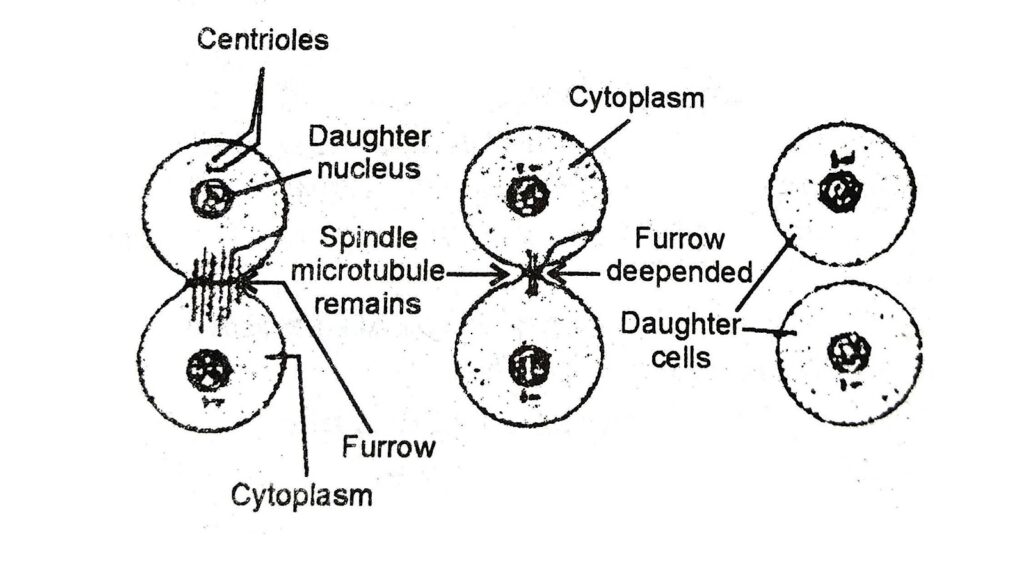
Fig. 4.46. Cytokinesis by furrowing in an animal cell.

Hi! my Name is Parimal Roy. I have completed my Bachelor’s degree in Philosophy (B.A.) from Silapathar General College. Currently, I am working as an HR Manager at Dev Library. It is a website that provides study materials for students from Class 3 to 12, including SCERT and NCERT notes. It also offers resources for BA, B.Com, B.Sc, and Computer Science, along with postgraduate notes. Besides study materials, the website has novels, eBooks, health and finance articles, biographies, quotes, and more.



